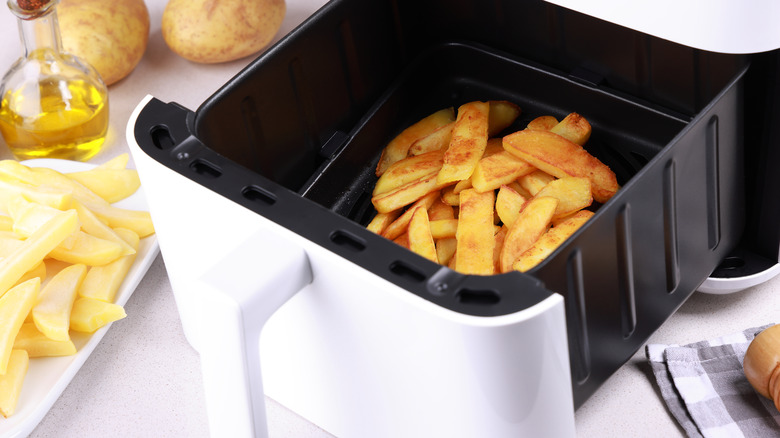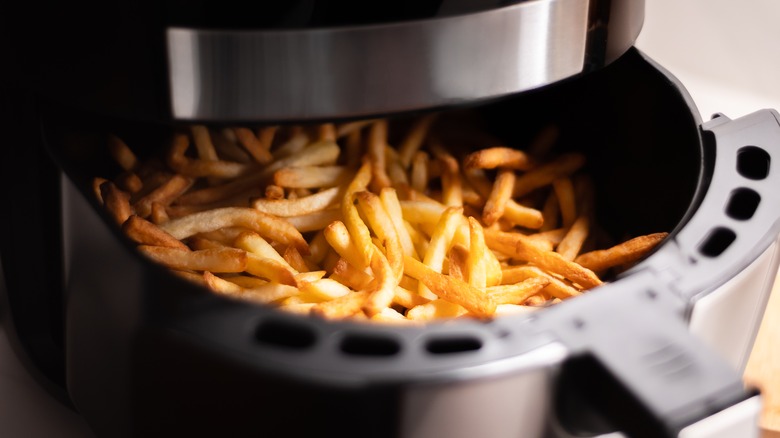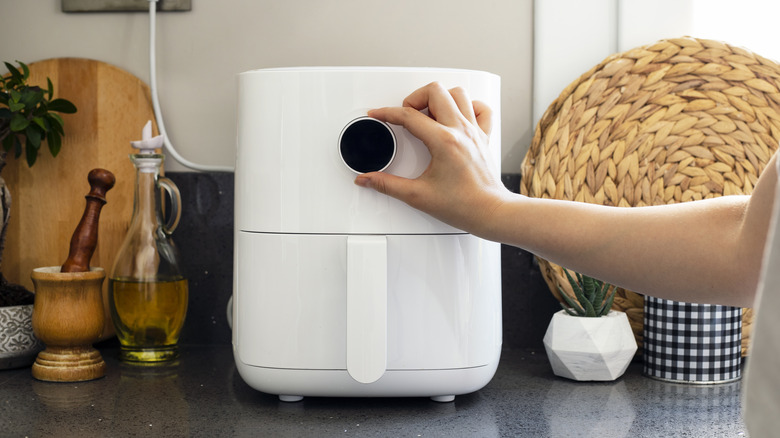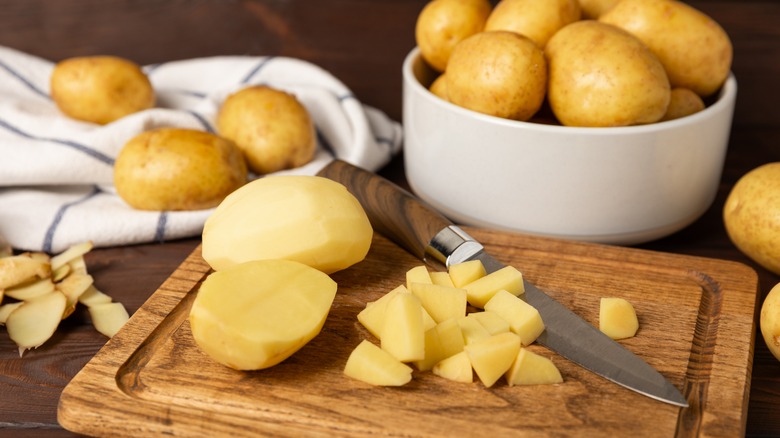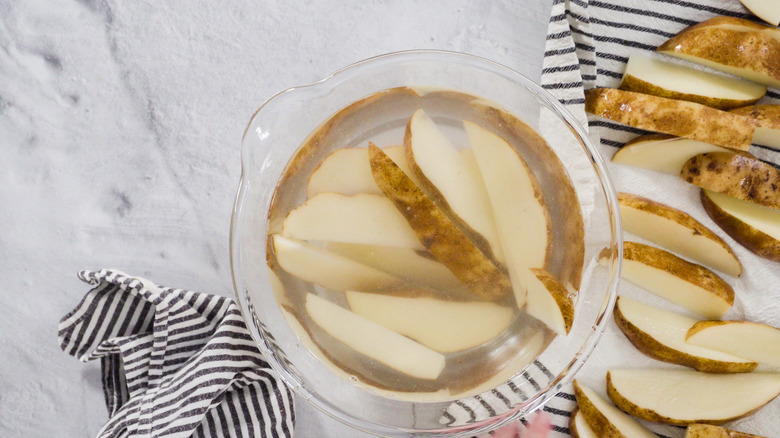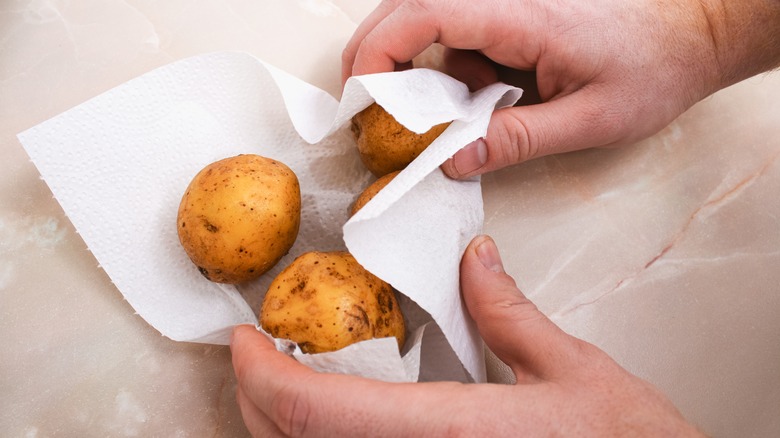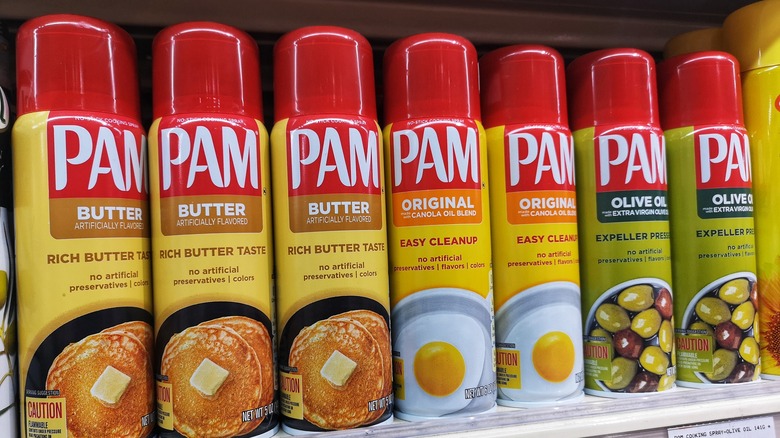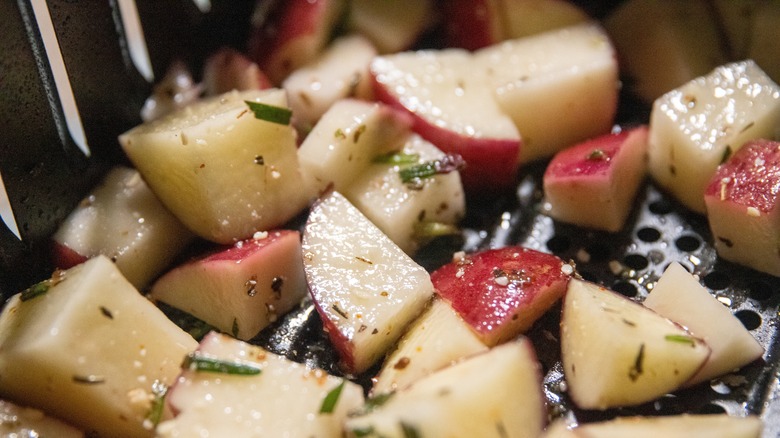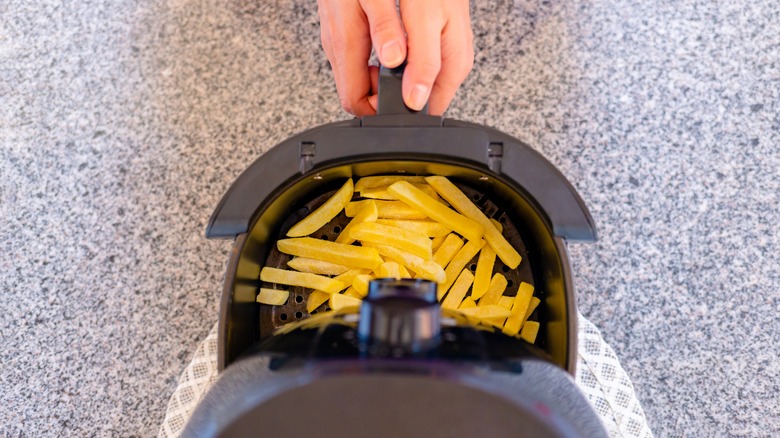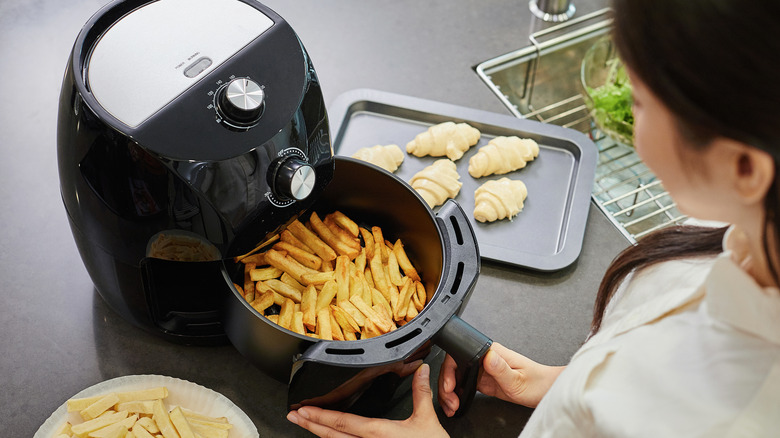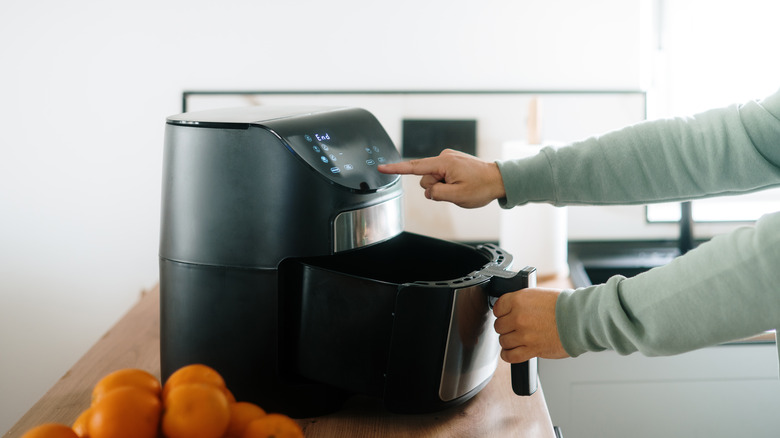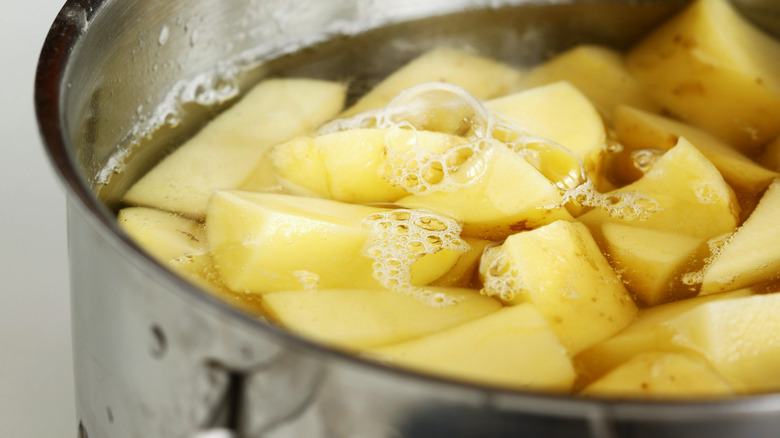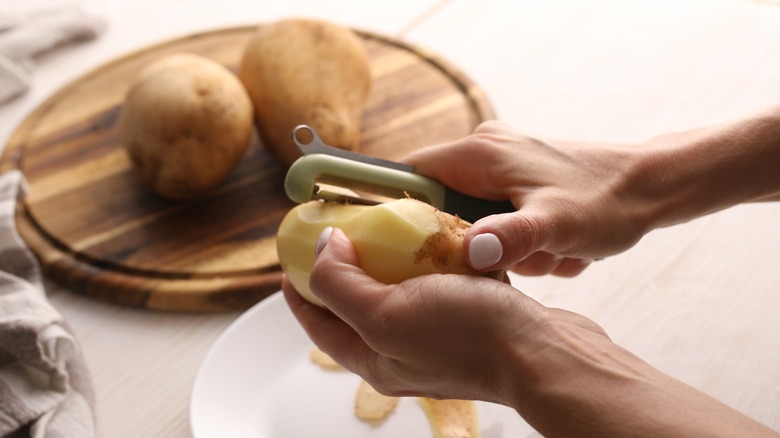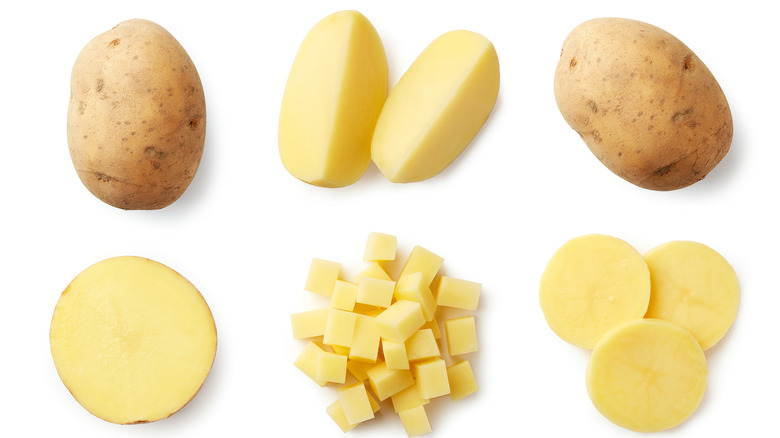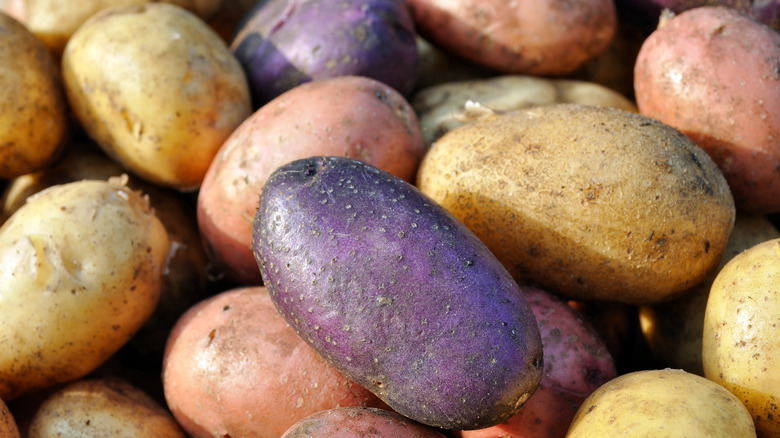Mistakes You Should Avoid When Cooking Potatoes In An Air Fryer
We may receive a commission on purchases made from links.
Air frying potatoes is often viewed as a healthier cooking method because it requires significantly less oil than a deep fryer or even roasting for that matter. When it comes to cooking potatoes, air frying is also super convenient, quick, and leads to spectacular results with a variety of recipes.
While air fryers are known for being incredibly easy to use, regardless of what you're making, there are a handful of mistakes you should avoid when using these handy appliances to cook potatoes. From not seasoning at the right time to forgetting to use oil to not soaking your potatoes in cold water before cooking, it's easy to overlook common blunders if you don't know what they are.
I searched through chef recommendations, food blogs, Reddit threads, and more to compile a list of common mistakes people make when air frying potatoes. I also considered my own experiences cooking potatoes in an air fryer, of which there are many (I air fry them weekly in my kitchen). Keep reading to find out what my research and home air fryer attempts taught me. That way you can easily avoid silly missteps moving forward and make perfect potatoes every time.
Trying to cook too many potatoes at one time
Overcrowding an air fryer is a big no-no — your food won't cook evenly and with potatoes, the difference is anything but negligible. While it varies from one recipe to the next, perfectly cooked potatoes are typically crispy on the outside and somewhat soft and fluffy inside. However, if you overcrowd your air fryer with potatoes, achieving crispy exteriors is unlikely. Some pieces may turn out as desired, but many will not.
Air fryers work similar to convection ovens. They exude high temperatures and circulate the hot air to help cook foods quickly. As a result, there needs to be space for the hot air to circulate. If the machine is overcrowded with food this simply isn't possible. Ideally, you want anywhere from a thin layer to about ⅓ or ½ full basket of food. Some air fryers come with multiple layers or handy insertable racks which effectively doubles the space you can line with foods — but either way, less than half full is preferred. Even if you want to save time, it is best to hold back and cook two batches.
Opting not to preheat the air fryer
For many dishes, preheating your air fryer may not be essential. After all, they get hot pretty quickly. Even so, skipping this step is a big mistake when making potatoes. When you put them in a preheated air fryer, they get crispier and cook more evenly. I've air fried potatoes both with and without preheating and honestly, I was surprised at how much of a difference it actually made. The ones I used to make without preheating were somewhat crispy, but they didn't compare to the ones made the right way — after preheating.
Thankfully, air fryers preheat much faster than a standard oven so it won't take long to get your appliance piping hot for potatoes. It varies slightly from one appliance to the next, but five minutes should be enough to heat up most air fryers. All things considered, that's not long, so make sure not to overlook or choose to skip this important step. If you do, it is just one of the many errors that lead to less than ideal potatoes.
Not taking the time to ensure the pieces of potato are evenly sized
Regardless of the cooking method, chopping your potatoes into evenly sized pieces is essential. It may take a little more time and attention while you prep, but it is the only way to get consistent results. When potatoes are cut into various sizes, it's impossible for them to cook evenly. Smaller pieces cook faster and larger pieces need more time. If you toss poorly chopped potatoes into the air fryer together, some come out perfectly cooked, others are undercooked, and a few will likely be overcooked. So, consistency is key if you strive for evenly cooked potatoes.
The easiest way to ensure evenly sized potatoes is to slice or dice them with a mandoline. Most mandolines have a range of settings for various cuts, allowing you to chop french fries, thin rounds, home fries, and more with ease. If you don't have a mandoline, you can also achieve fairly even cuts, but you'll have to hone in on your knife skills. Like other skills, practice makes perfect, but using a super sharp knife goes a long way when trying to make precise cuts.
Not soaking the potatoes in cold water first
One of the best, easiest ways to ensure your potatoes come out of the air fryer super crispy is to soak them in cold water before cooking. If you are throwing a meal together last minute it may be tempting to just toss your potatoes into the air fryer after you chop them. However, this would be a mistake. Sure, it can be done, but your potatoes certainly won't crisp up as nicely if you don't take the extra time to soak them first.
Soaking chopped potatoes helps them release some of the starch contained within. As a result, they are much less likely to become mushy while cooking. Instead, you get perfectly crispy potatoes –something we all want, right? Professional chefs and restaurants are no strangers to this technique but it doesn't take any special skills to pull it off. Simply chop your potatoes into the size you want and submerge them in cold or maybe even iced water. Then, leave them to soak for two hours up to a full day (but not longer). When enough time has passed, give them a quick rinse under cold running water and you're good to go.
Not patting the potatoes dry before air frying
After soaking your chopped potatoes in cold water — something we now know is key for achieving crispy results — you'll want to pat them dry with a clean towel or paper towel before putting them in your air fryer. Not only will this absorb any of the extra starch and water still lingering on the potatoes, but it prepares them for the next steps (which likely involve oil and seasoning if you're doing it right).
As you know, oil and water don't mix, so if you try to toss your chopped potatoes in oil while they are still wet it simply won't work. The oil will instantly separate as the water repels them from the potatoes. In addition, any seasonings you intend to use will also have trouble sufficiently coating the potatoes. So, it is best to avoid this mistake. If you don't, your potatoes may still turn out mushy and under seasoned. While an ice bath is extremely helpful, it could also lead to the downfall of your potatoes if you don't pat them dry before moving forward.
Skipping a light coating of oil -- or using cooking spray
For many people, an air fryer's ability to cook crispy foods without an abundance of oil is one of the main selling points. Compared to deep frying or pan frying, air fryers are seen as a healthy alternative. In fact, many appliance guidelines and home cooks say you can cut oil out of the equation entirely when cooking in an air fryer. Even so, when it comes to cooking potatoes, a little bit goes a long way, so don't make the mistake of listening to the hype. I have air fried potatoes both ways and, the potatoes I cook with a light coating of oil turn out infinitely better. The batches I've made without were dry, not nearly as crispy, and pretty lackluster overall.
Another common mistake people make when making potatoes or any food in an air fryer is reaching for the cooking spray. I know, it's super easy and quick, but cooking spray can actually be bad for your air fryer basket. Over time, the harsh chemicals in aerosol cooking sprays cause the non-stick coating to flake and peel off into your food.
So, what kind of oil should you use? It depends on what kind of potatoes you are cooking, but vegetable oil and peanut oil are popular choices because they have a high smoke point. I also use olive oil but feel free to play around — just stay away from aerosol cooking sprays.
Forgetting to season the potatoes generously before air frying
There's nothing wrong with sprinkling salt and other spices on freshly cooked potatoes. In fact, it's the best way to season deep fried potatoes. However, when it comes to air frying, salting and seasoning before cooking is ideal. Unlike the deep fryer, all of the seasoning won't fall off in an air fryer. Some will, but for the most part, it will stick to the potatoes fairly well, allowing the seasoning to seep in and flavor them throughout. I recommend adding salt and other seasonings right after you toss the potatoes in oil. This helps them effortlessly hold onto all the yummy flavor while they cook.
What seasonings you use are up to you, but I find potatoes aren't the same without a generous sprinkling of salt. When making baked potatoes, Ina Garten rubs the skins with salt and herbs before cooking to help them form the perfect crispy texture, so salt helps with more than just flavor. I also like to add garlic and onion powder when air frying potatoes, but depending on the recipe, pretty much anything goes. From chili powder to cumin to rosemary, they all taste delicious on potatoes.
Thawing frozen potatoes before air frying
You can air fry all different kinds of potatoes, and that includes frozen ones. Making potatoes from scratch is tasty and all, but sometimes you just need something quick and easy. Considering all we've learned so far about proper preparation, soaking in cold water, and more for raw potatoes, they may not be the best option if you're in a hurry. Don't worry, though. Frozen potatoes are ready to fill the gap. Best of all, you don't even have to thaw them before putting them in your air fryer. Actually, thawing them out would be a big mistake.
You shouldn't thaw frozen potatoes before air frying for two reasons: Texture and convenience. First, and most importantly, frozen potatoes become soggy if they are thawed out before cooking. As a result, this unnecessary step actually defeats the purpose of using an air fryer entirely. Second, why would you take the extra time to thaw out frozen potatoes if they cook in the air fryer perfectly straight out of the freezer? Thawing only makes the process less convenient, so there's nothing to gain.
Not shaking the potatoes at least once while cooking
Similar to many other foods, your air fryer does a better job of cooking potatoes if you give the basket a vigorous shake halfway through the cooking process. This flips the potatoes and allows different areas to be exposed. As a result, you wind up with more evenly cooked potatoes. If you overlook this step, the potatoes near the edges of your air fryer's basket will likely be cooked more than the ones in the middle.
Another benefit to shaking your potatoes midway is that it allows you to monitor their progress in real time. If needed, you can add a couple of extra minutes to the cooking time or take a few off. There's no need to wait for the cycle to finish before making adjustments. Considering how easy it is to pull out your air fryer's basket and give it a shake, there's really no reason why you should try to skip this step. Plus, most air fryers already beep at the halfway point, alerting you that it is time. It seriously couldn't be any easier, so no excuses.
Miscalculating cook times and temperatures when converting recipes for the air fryer
Air fryers are extremely popular, but many recipes haven't caught up to the craze yet. What this means is that you will likely need to convert cooking times and temperatures from other recipes to make them suitable for the air fryer. Fortunately, this is easily done for baking recipes if you know the right adjustments to make. In general, you want to reduce a baking recipe's temperature by about 25 degrees Fahrenheit when converting it for the air fryer. Simple enough, right? Next, you'll want to reduce cook times by approximately 20%.
If you're not super excited about working through equations or simply aren't sure your math skills are reliable enough to get the correct answer every time, you're in luck. There are several online tools, like the Air Fryer Calculator, that do the work for you. I admit, I use these tools all of the time — they eliminate my occasional guesswork and make converting recipes beyond easy.
Not experimenting with parboiling the potatoes
One of the best tricks you can use to make extra crispy potatoes involves parboiling (aka blanching) before cooking them. While this helps with various cooking processes and recipes, it makes a world of difference when air frying potatoes. I first saw this done in restaurant kitchens and thought it was simply to speed up cooking times, but it benefits potatoes in the crispy department as well. With this in mind, not experimenting with par-boiling your air fryer potatoes is a mistake. You might not do it every single time, but you should know how it affects the results at the very least.
Blanching potatoes is as easy as boiling them for a few minutes. If you are making potato sticks, start by cleaning and cutting your potatoes. Then, boil them for about four minutes. This gives the centers of the potatoes a significant head start. After air frying, the result is perfectly cooked potatoes all the way through. Once you take them out of the boiling water, put them directly into an ice bath. After a couple of hours, they'll be ready for the air fryer.
Peeling the skins off the potatoes
Aside from baked potatoes, many people start prepping potatoes by peeling the skins off. They are often covered in dirt and crevices and peeling the skins makes cleaning much easier. While this isn't a deal-breaker, it is a mistake if you are trying to make ultra crispy potatoes. When the skins are left on, they add a delicious layer of crunch to your air fried potatoes. Some people prefer skinless potatoes when it comes to making fries, but I don't see the appeal. Why would I want to create extra work for myself and reduce crispiness in the process? That's why I always leave the skins on, even if I'm not using the air fryer.
When leaving potato skins on, it is important to vigorously scrub them before chopping. You want to remove all of the dirt before cutting into them. Otherwise, it can easily transfer to other parts of the potato, and no one wants to taste dirt when they bite into beautifully cooked potatoes, right? A quick scrub under running water with a soft bristled brush or a vigorous rub with your hands should get the job done in no time.
Limiting yourself to just one recipe
In my house, when we think about air frying potatoes it typically means making french fries. In your home, the go-to potato recipe may be something else, like roasted rounds — but either way, limiting yourself to just one potato recipe in the air fryer is a big mistake. Air fryers are capable of much more than that.
I've experimented with quite a few potato recipes in the air fryer and as noted, French fries are my favorite. Even so, I've expanded my repertoire beyond that in the last couple of years and I certainly don't regret it. Air fryers are great at cooking baked potatoes, hash browns, home fries, potato skins, wedges, and just about any kind of potato recipe you can think of. As it turns out, air frying is one of the best ways to cook a baked potato too, so make sure to give it a try. I've even reheated mashed potatoes in my air fryer and they turned out alright. In addition, your air fryer is superior for reheating french fries. It has the power to crisp them up much better than the oven and while they won't necessarily be restored to their original glory, they'll be pretty close.
Using the wrong type of potato for the recipe
The final mistake you want to avoid when air frying potatoes is using the wrong spud for the recipe. There are many different types of potatoes, but for the most part, they fall into three categories: waxy, starchy, and all-purpose. Depending on the dish, some work better than others. For example, waxy potatoes have more resilient skins, so they hold up better while cooking. Starchy potatoes fluff up while cooking, making them better for absorbing butter and other toppings like gravy. As the name suggests, all-purpose potatoes are good for most jobs.
When making baked potatoes, I use starchy potatoes like Russets because the centers become fluffy and perfect for soaking up a myriad of toppings, like sour cream and butter. For a chunky potato recipe, I opt for waxy potatoes like baby reds. When I'm making fries or am unsure about a particular recipe and which potato would work best, I choose all-purpose spuds.

